Analysis of Real GDP and Total Factor Productivity of Selected Economies
VerifiedAdded on 2023/04/23
|17
|3921
|467
AI Summary
This report analyzes the real GDP and total factor productivity of selected economies including Australia, China, France, Germany, Japan, Spain, United Kingdom, and United States. It also includes per capita GDP, import values, government debt, and final expenditure of the government. One of the major similarities between the real GDP and the TFP among all the chosen economies is that they are increasing over the years. While the GDP in real terms measure the actual performance, the Total Factor Productivity measures the efficiency of the labours used in the production processes.
Contribute Materials
Your contribution can guide someone’s learning journey. Share your
documents today.
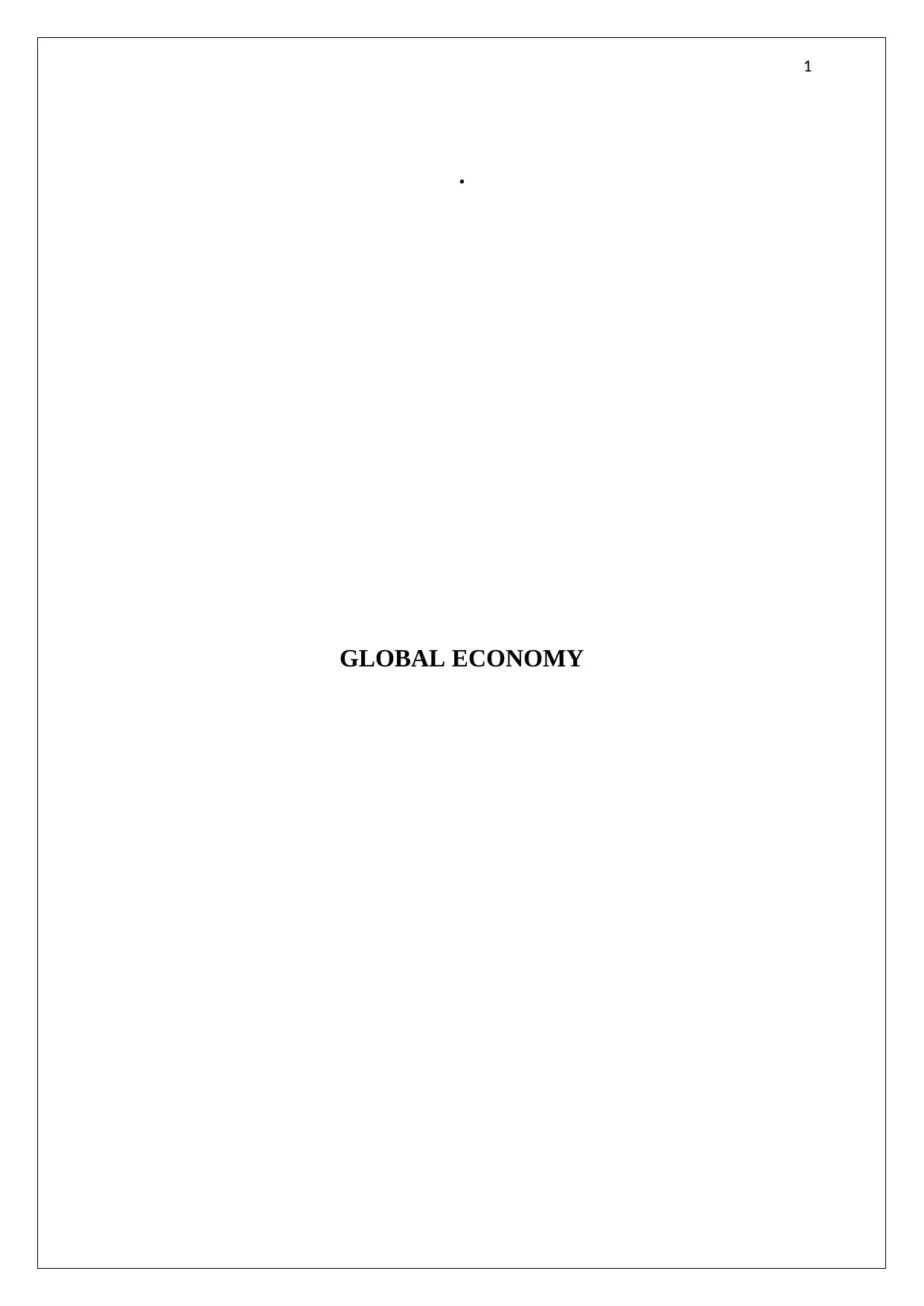
1
.
GLOBAL ECONOMY
.
GLOBAL ECONOMY
Secure Best Marks with AI Grader
Need help grading? Try our AI Grader for instant feedback on your assignments.

2
Contents
Part A- Data collection, Presentation and analysis....................................................................3
Part B- Short answer question..................................................................................................12
Part C........................................................................................................................................12
Reference..................................................................................................................................15
Contents
Part A- Data collection, Presentation and analysis....................................................................3
Part B- Short answer question..................................................................................................12
Part C........................................................................................................................................12
Reference..................................................................................................................................15
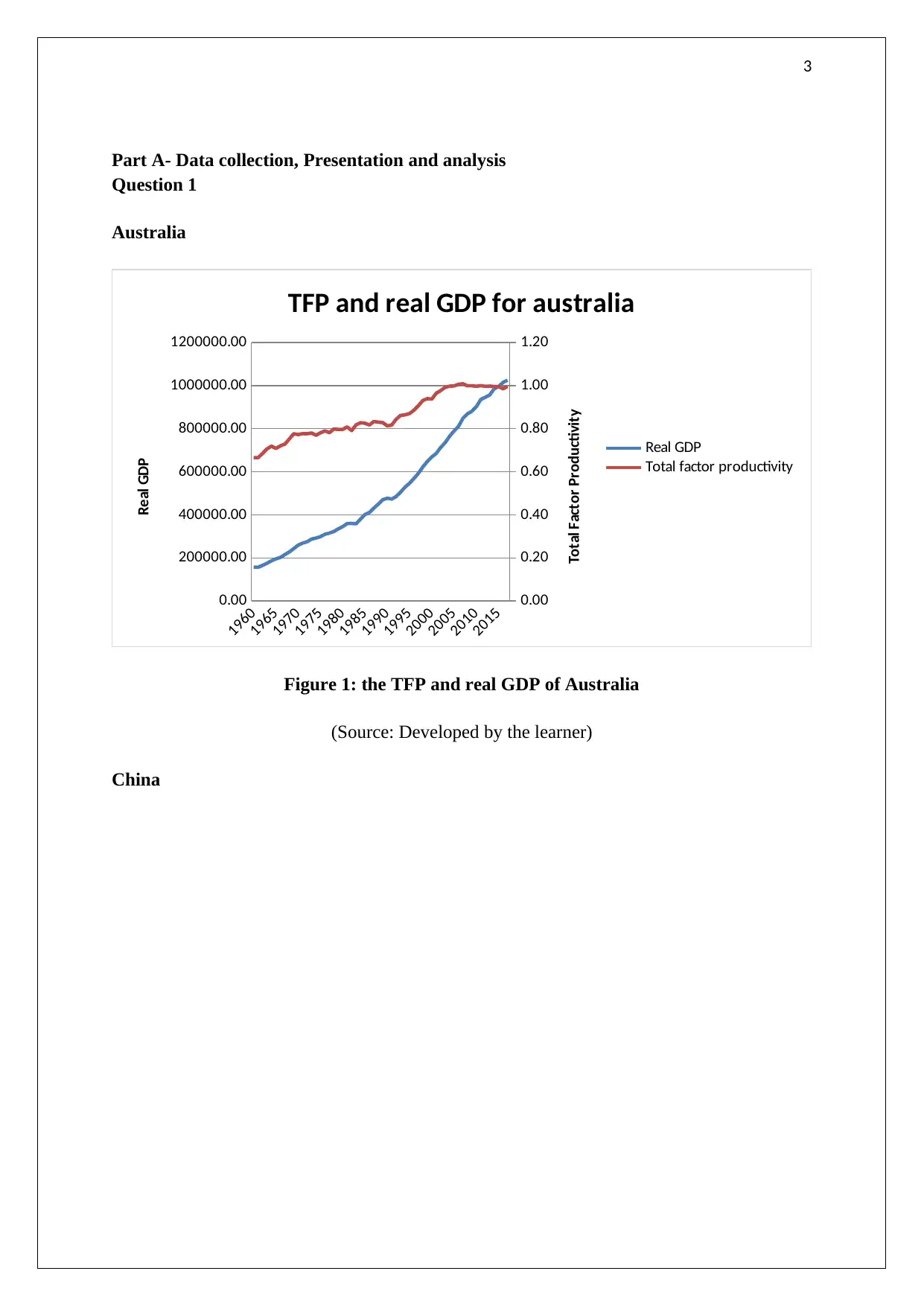
3
Part A- Data collection, Presentation and analysis
Question 1
Australia
1960
1965
1970
1975
1980
1985
1990
1995
2000
2005
2010
2015
0.00
200000.00
400000.00
600000.00
800000.00
1000000.00
1200000.00
0.00
0.20
0.40
0.60
0.80
1.00
1.20
TFP and real GDP for australia
Real GDP
Total factor productivity
Real GDP
Total Factor Productivity
Figure 1: the TFP and real GDP of Australia
(Source: Developed by the learner)
China
Part A- Data collection, Presentation and analysis
Question 1
Australia
1960
1965
1970
1975
1980
1985
1990
1995
2000
2005
2010
2015
0.00
200000.00
400000.00
600000.00
800000.00
1000000.00
1200000.00
0.00
0.20
0.40
0.60
0.80
1.00
1.20
TFP and real GDP for australia
Real GDP
Total factor productivity
Real GDP
Total Factor Productivity
Figure 1: the TFP and real GDP of Australia
(Source: Developed by the learner)
China
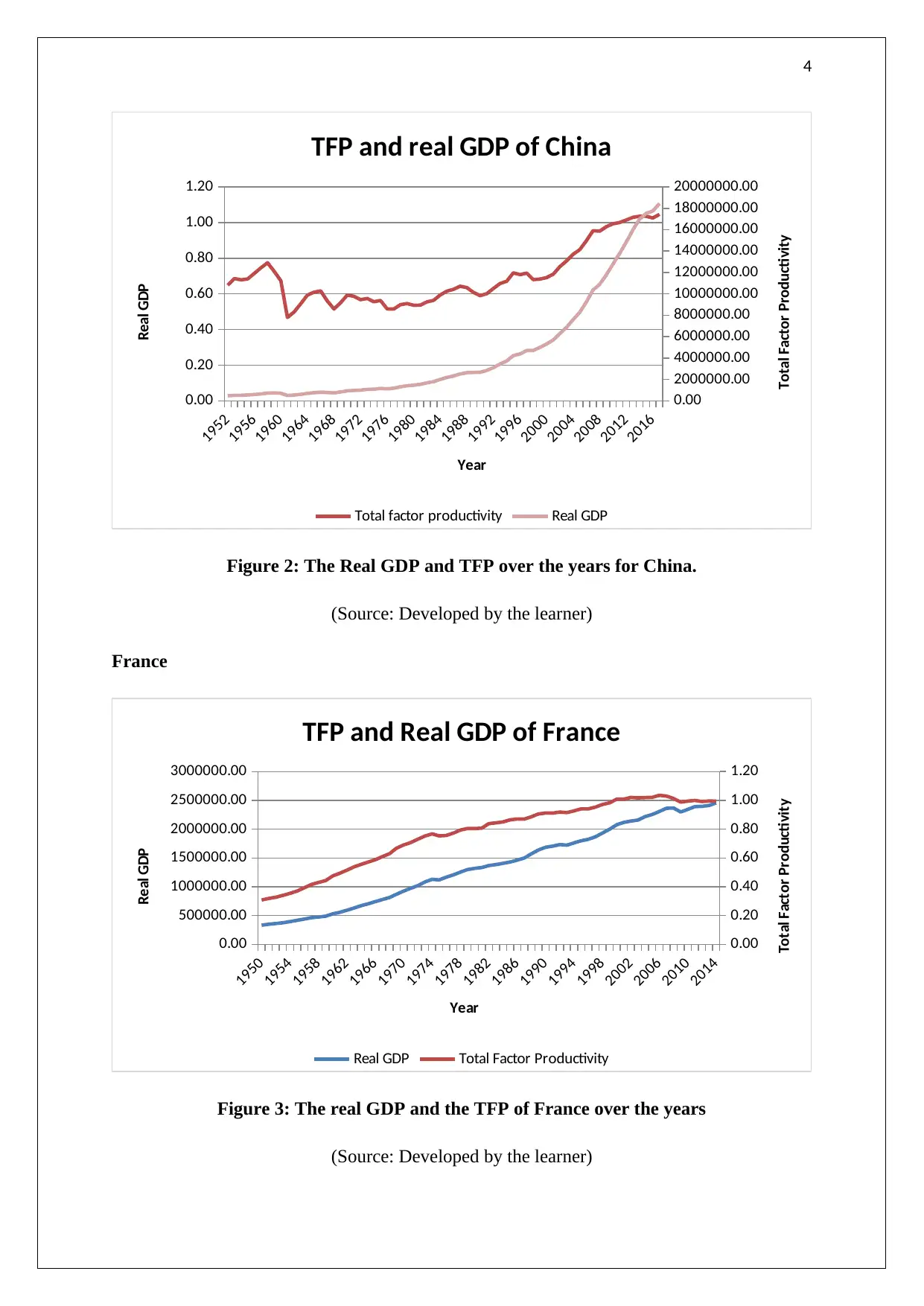
4
1952
1956
1960
1964
1968
1972
1976
1980
1984
1988
1992
1996
2000
2004
2008
2012
2016
0.00
0.20
0.40
0.60
0.80
1.00
1.20
0.00
2000000.00
4000000.00
6000000.00
8000000.00
10000000.00
12000000.00
14000000.00
16000000.00
18000000.00
20000000.00
TFP and real GDP of China
Total factor productivity Real GDP
Year
Real GDP
Total Factor Productivity
Figure 2: The Real GDP and TFP over the years for China.
(Source: Developed by the learner)
France
1950
1954
1958
1962
1966
1970
1974
1978
1982
1986
1990
1994
1998
2002
2006
2010
2014
0.00
500000.00
1000000.00
1500000.00
2000000.00
2500000.00
3000000.00
0.00
0.20
0.40
0.60
0.80
1.00
1.20
TFP and Real GDP of France
Real GDP Total Factor Productivity
Year
Real GDP
Total Factor Productivity
Figure 3: The real GDP and the TFP of France over the years
(Source: Developed by the learner)
1952
1956
1960
1964
1968
1972
1976
1980
1984
1988
1992
1996
2000
2004
2008
2012
2016
0.00
0.20
0.40
0.60
0.80
1.00
1.20
0.00
2000000.00
4000000.00
6000000.00
8000000.00
10000000.00
12000000.00
14000000.00
16000000.00
18000000.00
20000000.00
TFP and real GDP of China
Total factor productivity Real GDP
Year
Real GDP
Total Factor Productivity
Figure 2: The Real GDP and TFP over the years for China.
(Source: Developed by the learner)
France
1950
1954
1958
1962
1966
1970
1974
1978
1982
1986
1990
1994
1998
2002
2006
2010
2014
0.00
500000.00
1000000.00
1500000.00
2000000.00
2500000.00
3000000.00
0.00
0.20
0.40
0.60
0.80
1.00
1.20
TFP and Real GDP of France
Real GDP Total Factor Productivity
Year
Real GDP
Total Factor Productivity
Figure 3: The real GDP and the TFP of France over the years
(Source: Developed by the learner)
Secure Best Marks with AI Grader
Need help grading? Try our AI Grader for instant feedback on your assignments.
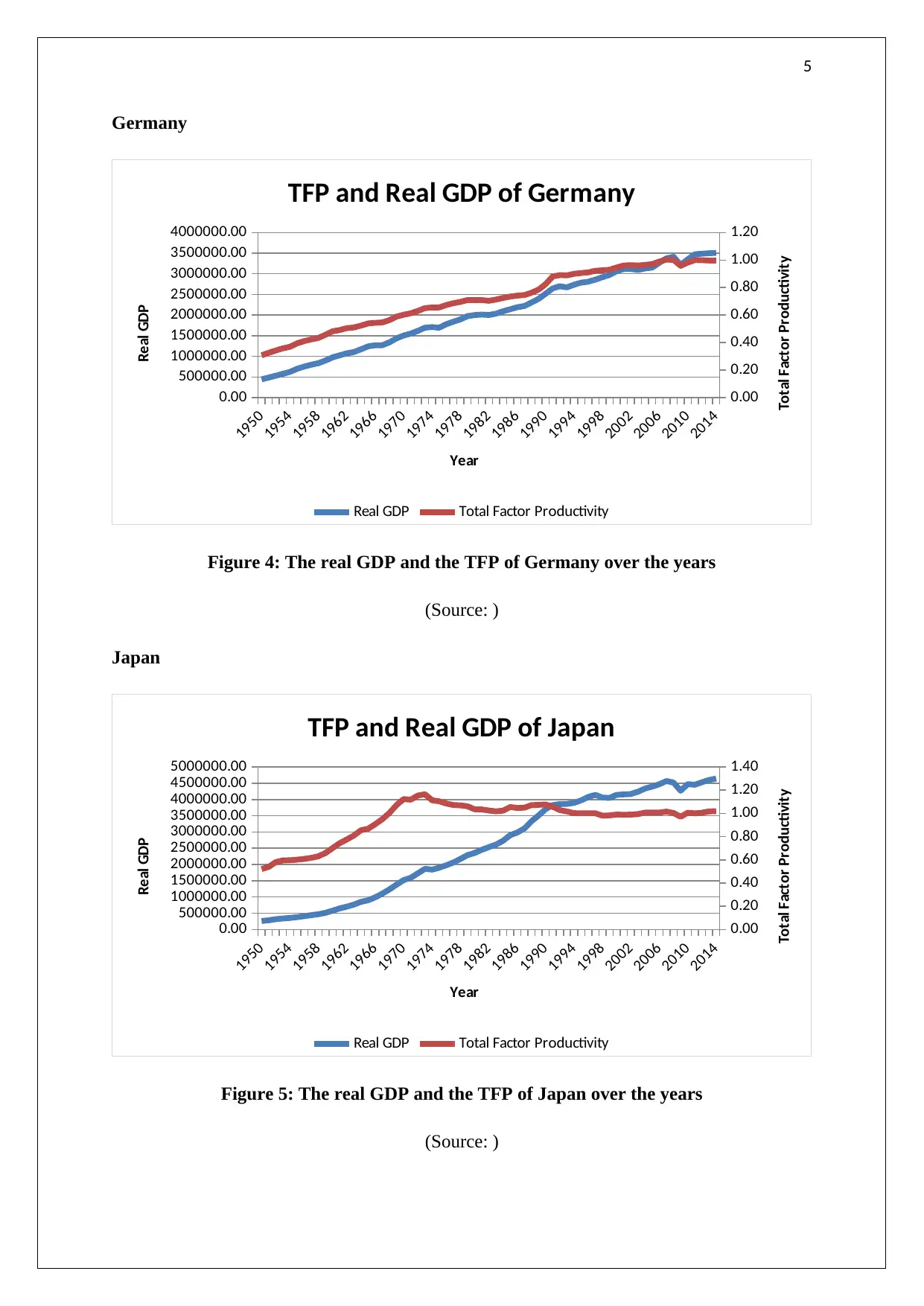
5
Germany
1950
1954
1958
1962
1966
1970
1974
1978
1982
1986
1990
1994
1998
2002
2006
2010
2014
0.00
500000.00
1000000.00
1500000.00
2000000.00
2500000.00
3000000.00
3500000.00
4000000.00
0.00
0.20
0.40
0.60
0.80
1.00
1.20
TFP and Real GDP of Germany
Real GDP Total Factor Productivity
Year
Real GDP
Total Factor Productivity
Figure 4: The real GDP and the TFP of Germany over the years
(Source: )
Japan
1950
1954
1958
1962
1966
1970
1974
1978
1982
1986
1990
1994
1998
2002
2006
2010
2014
0.00
500000.00
1000000.00
1500000.00
2000000.00
2500000.00
3000000.00
3500000.00
4000000.00
4500000.00
5000000.00
0.00
0.20
0.40
0.60
0.80
1.00
1.20
1.40
TFP and Real GDP of Japan
Real GDP Total Factor Productivity
Year
Real GDP
Total Factor Productivity
Figure 5: The real GDP and the TFP of Japan over the years
(Source: )
Germany
1950
1954
1958
1962
1966
1970
1974
1978
1982
1986
1990
1994
1998
2002
2006
2010
2014
0.00
500000.00
1000000.00
1500000.00
2000000.00
2500000.00
3000000.00
3500000.00
4000000.00
0.00
0.20
0.40
0.60
0.80
1.00
1.20
TFP and Real GDP of Germany
Real GDP Total Factor Productivity
Year
Real GDP
Total Factor Productivity
Figure 4: The real GDP and the TFP of Germany over the years
(Source: )
Japan
1950
1954
1958
1962
1966
1970
1974
1978
1982
1986
1990
1994
1998
2002
2006
2010
2014
0.00
500000.00
1000000.00
1500000.00
2000000.00
2500000.00
3000000.00
3500000.00
4000000.00
4500000.00
5000000.00
0.00
0.20
0.40
0.60
0.80
1.00
1.20
1.40
TFP and Real GDP of Japan
Real GDP Total Factor Productivity
Year
Real GDP
Total Factor Productivity
Figure 5: The real GDP and the TFP of Japan over the years
(Source: )
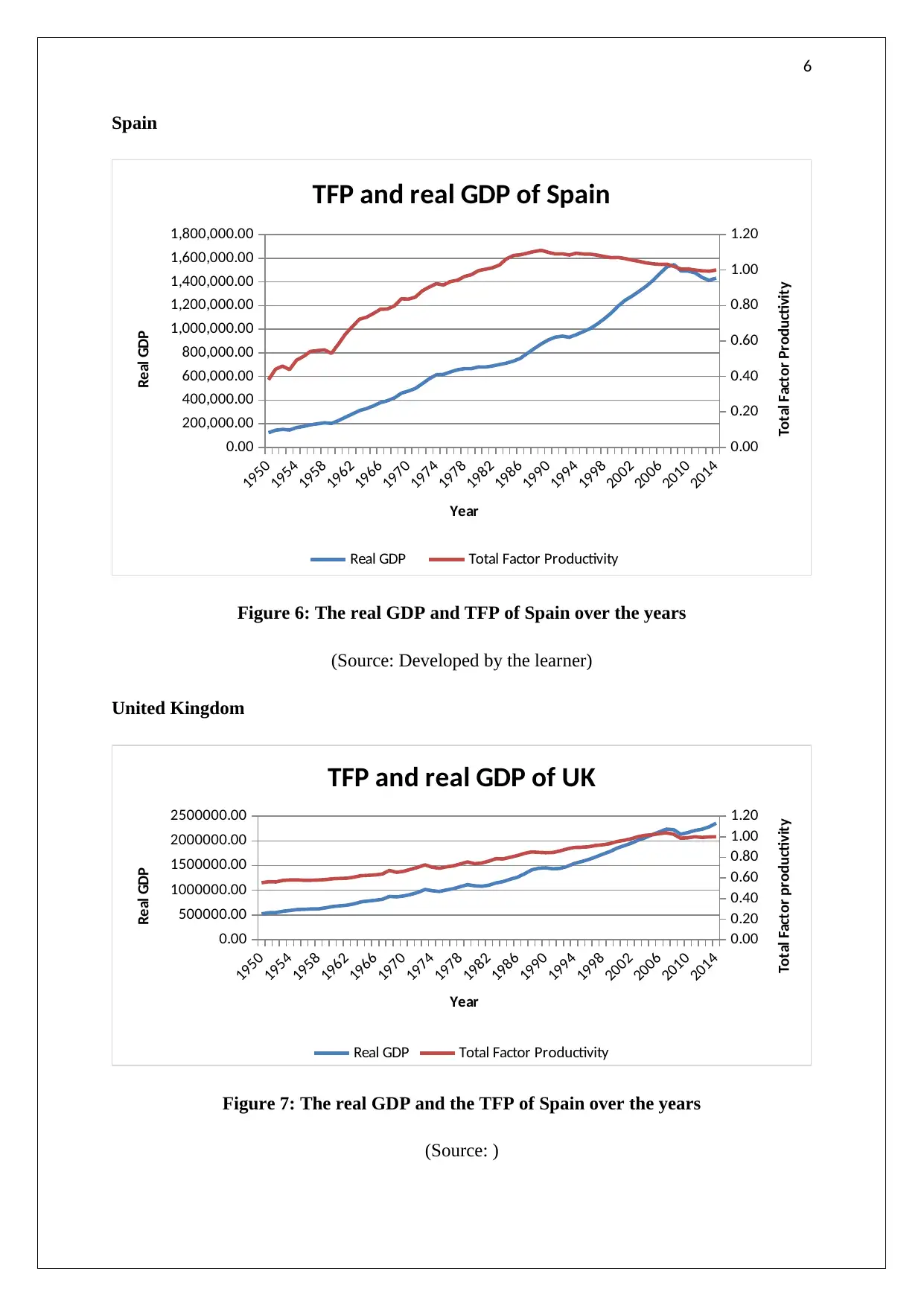
6
Spain
1950
1954
1958
1962
1966
1970
1974
1978
1982
1986
1990
1994
1998
2002
2006
2010
2014
0.00
200,000.00
400,000.00
600,000.00
800,000.00
1,000,000.00
1,200,000.00
1,400,000.00
1,600,000.00
1,800,000.00
0.00
0.20
0.40
0.60
0.80
1.00
1.20
TFP and real GDP of Spain
Real GDP Total Factor Productivity
Year
Real GDP
Total Factor Productivity
Figure 6: The real GDP and TFP of Spain over the years
(Source: Developed by the learner)
United Kingdom
1950
1954
1958
1962
1966
1970
1974
1978
1982
1986
1990
1994
1998
2002
2006
2010
2014
0.00
500000.00
1000000.00
1500000.00
2000000.00
2500000.00
0.00
0.20
0.40
0.60
0.80
1.00
1.20
TFP and real GDP of UK
Real GDP Total Factor Productivity
Year
Real GDP
Total Factor productivity
Figure 7: The real GDP and the TFP of Spain over the years
(Source: )
Spain
1950
1954
1958
1962
1966
1970
1974
1978
1982
1986
1990
1994
1998
2002
2006
2010
2014
0.00
200,000.00
400,000.00
600,000.00
800,000.00
1,000,000.00
1,200,000.00
1,400,000.00
1,600,000.00
1,800,000.00
0.00
0.20
0.40
0.60
0.80
1.00
1.20
TFP and real GDP of Spain
Real GDP Total Factor Productivity
Year
Real GDP
Total Factor Productivity
Figure 6: The real GDP and TFP of Spain over the years
(Source: Developed by the learner)
United Kingdom
1950
1954
1958
1962
1966
1970
1974
1978
1982
1986
1990
1994
1998
2002
2006
2010
2014
0.00
500000.00
1000000.00
1500000.00
2000000.00
2500000.00
0.00
0.20
0.40
0.60
0.80
1.00
1.20
TFP and real GDP of UK
Real GDP Total Factor Productivity
Year
Real GDP
Total Factor productivity
Figure 7: The real GDP and the TFP of Spain over the years
(Source: )
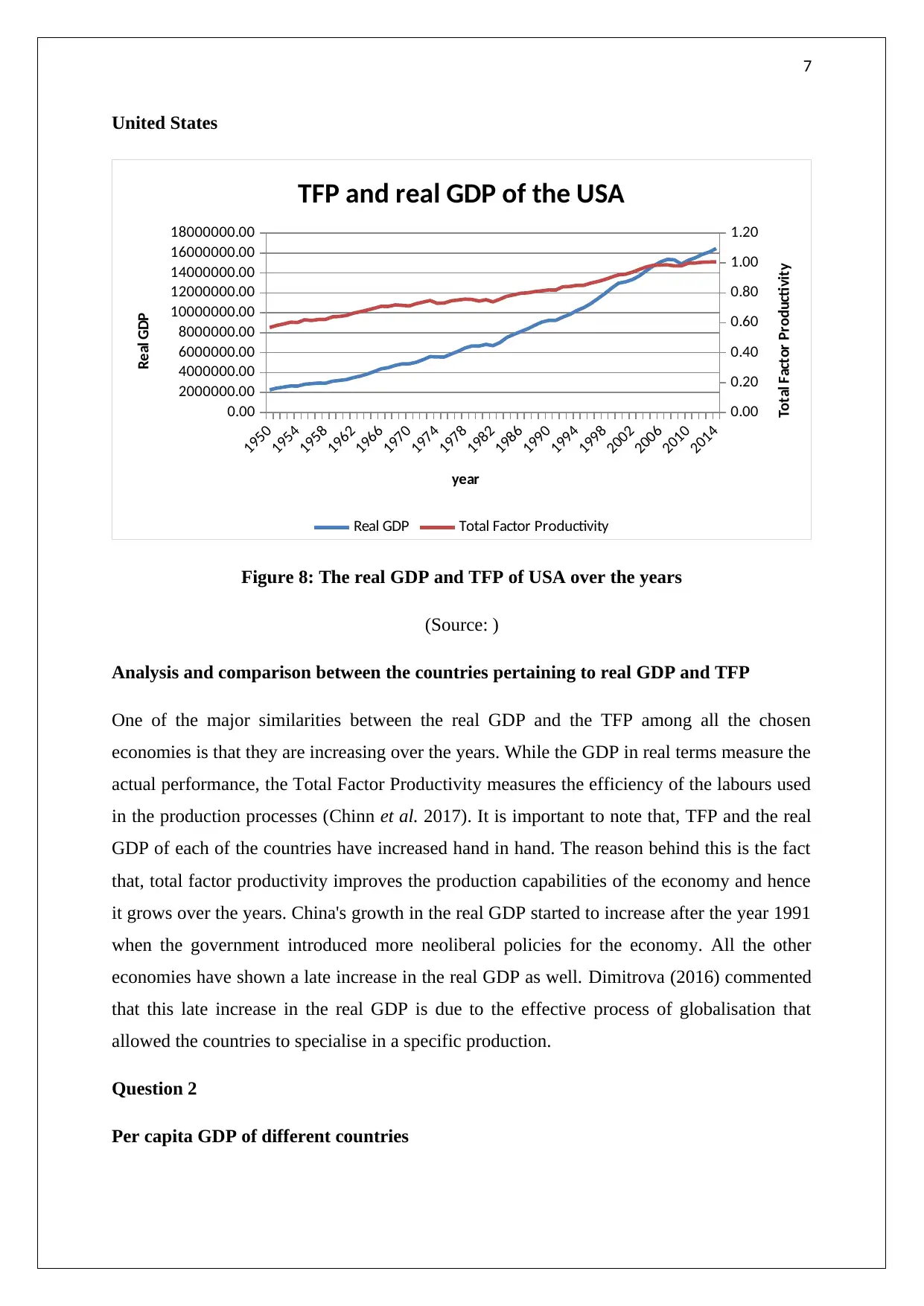
7
United States
1950
1954
1958
1962
1966
1970
1974
1978
1982
1986
1990
1994
1998
2002
2006
2010
2014
0.00
2000000.00
4000000.00
6000000.00
8000000.00
10000000.00
12000000.00
14000000.00
16000000.00
18000000.00
0.00
0.20
0.40
0.60
0.80
1.00
1.20
TFP and real GDP of the USA
Real GDP Total Factor Productivity
year
Real GDP
Total Factor Productivity
Figure 8: The real GDP and TFP of USA over the years
(Source: )
Analysis and comparison between the countries pertaining to real GDP and TFP
One of the major similarities between the real GDP and the TFP among all the chosen
economies is that they are increasing over the years. While the GDP in real terms measure the
actual performance, the Total Factor Productivity measures the efficiency of the labours used
in the production processes (Chinn et al. 2017). It is important to note that, TFP and the real
GDP of each of the countries have increased hand in hand. The reason behind this is the fact
that, total factor productivity improves the production capabilities of the economy and hence
it grows over the years. China's growth in the real GDP started to increase after the year 1991
when the government introduced more neoliberal policies for the economy. All the other
economies have shown a late increase in the real GDP as well. Dimitrova (2016) commented
that this late increase in the real GDP is due to the effective process of globalisation that
allowed the countries to specialise in a specific production.
Question 2
Per capita GDP of different countries
United States
1950
1954
1958
1962
1966
1970
1974
1978
1982
1986
1990
1994
1998
2002
2006
2010
2014
0.00
2000000.00
4000000.00
6000000.00
8000000.00
10000000.00
12000000.00
14000000.00
16000000.00
18000000.00
0.00
0.20
0.40
0.60
0.80
1.00
1.20
TFP and real GDP of the USA
Real GDP Total Factor Productivity
year
Real GDP
Total Factor Productivity
Figure 8: The real GDP and TFP of USA over the years
(Source: )
Analysis and comparison between the countries pertaining to real GDP and TFP
One of the major similarities between the real GDP and the TFP among all the chosen
economies is that they are increasing over the years. While the GDP in real terms measure the
actual performance, the Total Factor Productivity measures the efficiency of the labours used
in the production processes (Chinn et al. 2017). It is important to note that, TFP and the real
GDP of each of the countries have increased hand in hand. The reason behind this is the fact
that, total factor productivity improves the production capabilities of the economy and hence
it grows over the years. China's growth in the real GDP started to increase after the year 1991
when the government introduced more neoliberal policies for the economy. All the other
economies have shown a late increase in the real GDP as well. Dimitrova (2016) commented
that this late increase in the real GDP is due to the effective process of globalisation that
allowed the countries to specialise in a specific production.
Question 2
Per capita GDP of different countries
Paraphrase This Document
Need a fresh take? Get an instant paraphrase of this document with our AI Paraphraser
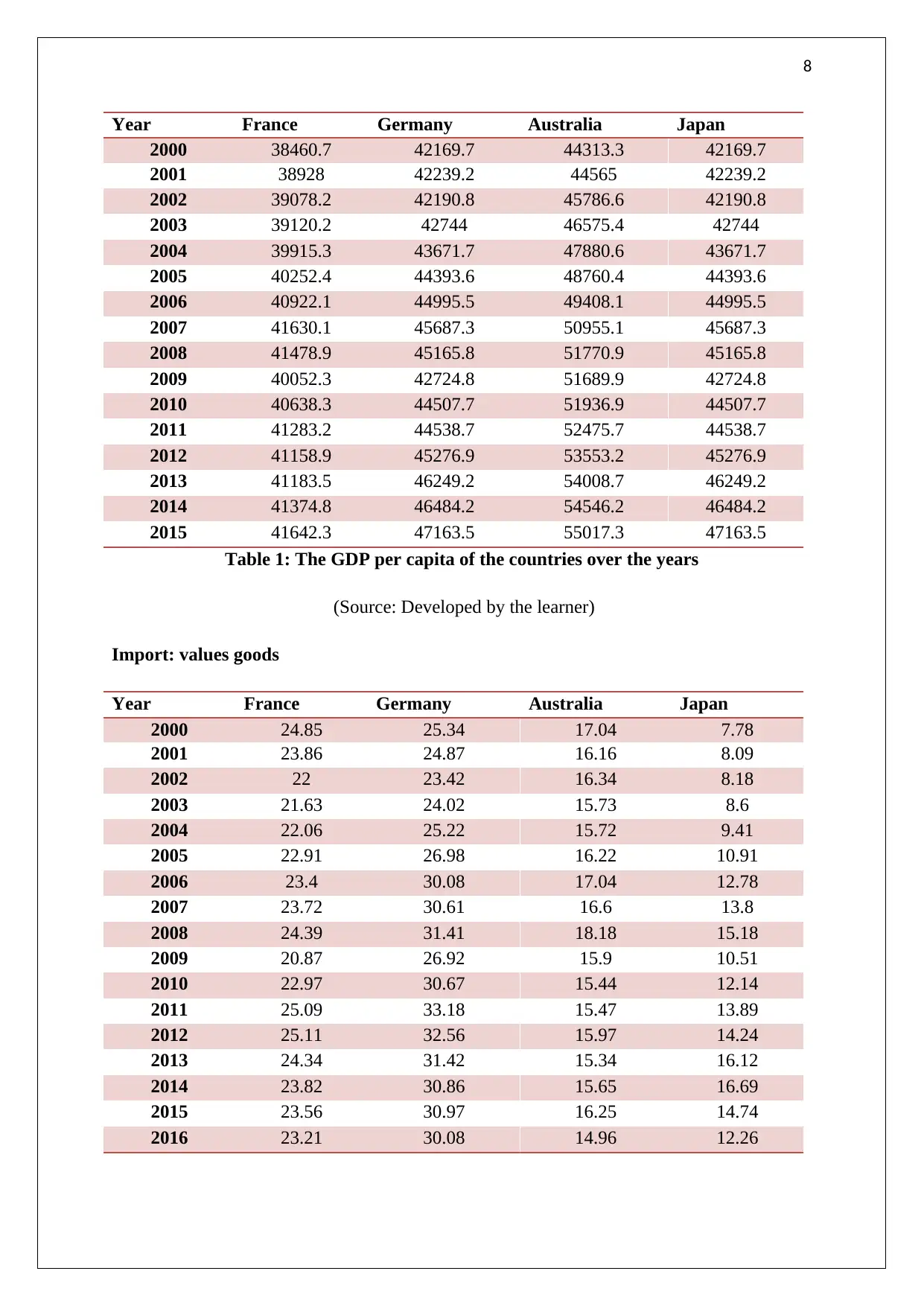
8
Year France Germany Australia Japan
2000 38460.7 42169.7 44313.3 42169.7
2001 38928 42239.2 44565 42239.2
2002 39078.2 42190.8 45786.6 42190.8
2003 39120.2 42744 46575.4 42744
2004 39915.3 43671.7 47880.6 43671.7
2005 40252.4 44393.6 48760.4 44393.6
2006 40922.1 44995.5 49408.1 44995.5
2007 41630.1 45687.3 50955.1 45687.3
2008 41478.9 45165.8 51770.9 45165.8
2009 40052.3 42724.8 51689.9 42724.8
2010 40638.3 44507.7 51936.9 44507.7
2011 41283.2 44538.7 52475.7 44538.7
2012 41158.9 45276.9 53553.2 45276.9
2013 41183.5 46249.2 54008.7 46249.2
2014 41374.8 46484.2 54546.2 46484.2
2015 41642.3 47163.5 55017.3 47163.5
Table 1: The GDP per capita of the countries over the years
(Source: Developed by the learner)
Import: values goods
Year France Germany Australia Japan
2000 24.85 25.34 17.04 7.78
2001 23.86 24.87 16.16 8.09
2002 22 23.42 16.34 8.18
2003 21.63 24.02 15.73 8.6
2004 22.06 25.22 15.72 9.41
2005 22.91 26.98 16.22 10.91
2006 23.4 30.08 17.04 12.78
2007 23.72 30.61 16.6 13.8
2008 24.39 31.41 18.18 15.18
2009 20.87 26.92 15.9 10.51
2010 22.97 30.67 15.44 12.14
2011 25.09 33.18 15.47 13.89
2012 25.11 32.56 15.97 14.24
2013 24.34 31.42 15.34 16.12
2014 23.82 30.86 15.65 16.69
2015 23.56 30.97 16.25 14.74
2016 23.21 30.08 14.96 12.26
Year France Germany Australia Japan
2000 38460.7 42169.7 44313.3 42169.7
2001 38928 42239.2 44565 42239.2
2002 39078.2 42190.8 45786.6 42190.8
2003 39120.2 42744 46575.4 42744
2004 39915.3 43671.7 47880.6 43671.7
2005 40252.4 44393.6 48760.4 44393.6
2006 40922.1 44995.5 49408.1 44995.5
2007 41630.1 45687.3 50955.1 45687.3
2008 41478.9 45165.8 51770.9 45165.8
2009 40052.3 42724.8 51689.9 42724.8
2010 40638.3 44507.7 51936.9 44507.7
2011 41283.2 44538.7 52475.7 44538.7
2012 41158.9 45276.9 53553.2 45276.9
2013 41183.5 46249.2 54008.7 46249.2
2014 41374.8 46484.2 54546.2 46484.2
2015 41642.3 47163.5 55017.3 47163.5
Table 1: The GDP per capita of the countries over the years
(Source: Developed by the learner)
Import: values goods
Year France Germany Australia Japan
2000 24.85 25.34 17.04 7.78
2001 23.86 24.87 16.16 8.09
2002 22 23.42 16.34 8.18
2003 21.63 24.02 15.73 8.6
2004 22.06 25.22 15.72 9.41
2005 22.91 26.98 16.22 10.91
2006 23.4 30.08 17.04 12.78
2007 23.72 30.61 16.6 13.8
2008 24.39 31.41 18.18 15.18
2009 20.87 26.92 15.9 10.51
2010 22.97 30.67 15.44 12.14
2011 25.09 33.18 15.47 13.89
2012 25.11 32.56 15.97 14.24
2013 24.34 31.42 15.34 16.12
2014 23.82 30.86 15.65 16.69
2015 23.56 30.97 16.25 14.74
2016 23.21 30.08 14.96 12.26
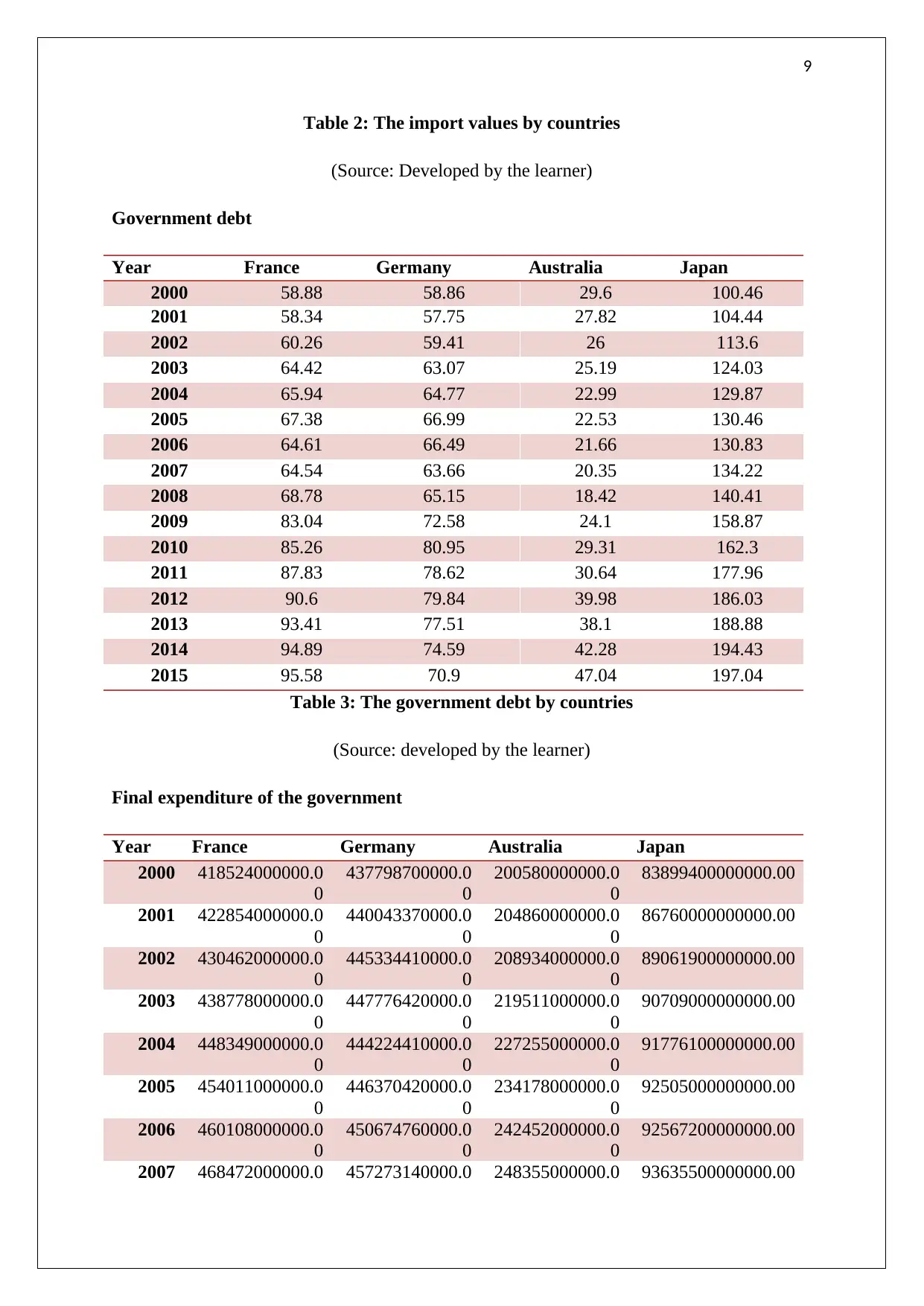
9
Table 2: The import values by countries
(Source: Developed by the learner)
Government debt
Year France Germany Australia Japan
2000 58.88 58.86 29.6 100.46
2001 58.34 57.75 27.82 104.44
2002 60.26 59.41 26 113.6
2003 64.42 63.07 25.19 124.03
2004 65.94 64.77 22.99 129.87
2005 67.38 66.99 22.53 130.46
2006 64.61 66.49 21.66 130.83
2007 64.54 63.66 20.35 134.22
2008 68.78 65.15 18.42 140.41
2009 83.04 72.58 24.1 158.87
2010 85.26 80.95 29.31 162.3
2011 87.83 78.62 30.64 177.96
2012 90.6 79.84 39.98 186.03
2013 93.41 77.51 38.1 188.88
2014 94.89 74.59 42.28 194.43
2015 95.58 70.9 47.04 197.04
Table 3: The government debt by countries
(Source: developed by the learner)
Final expenditure of the government
Year France Germany Australia Japan
2000 418524000000.0
0
437798700000.0
0
200580000000.0
0
83899400000000.00
2001 422854000000.0
0
440043370000.0
0
204860000000.0
0
86760000000000.00
2002 430462000000.0
0
445334410000.0
0
208934000000.0
0
89061900000000.00
2003 438778000000.0
0
447776420000.0
0
219511000000.0
0
90709000000000.00
2004 448349000000.0
0
444224410000.0
0
227255000000.0
0
91776100000000.00
2005 454011000000.0
0
446370420000.0
0
234178000000.0
0
92505000000000.00
2006 460108000000.0
0
450674760000.0
0
242452000000.0
0
92567200000000.00
2007 468472000000.0 457273140000.0 248355000000.0 93635500000000.00
Table 2: The import values by countries
(Source: Developed by the learner)
Government debt
Year France Germany Australia Japan
2000 58.88 58.86 29.6 100.46
2001 58.34 57.75 27.82 104.44
2002 60.26 59.41 26 113.6
2003 64.42 63.07 25.19 124.03
2004 65.94 64.77 22.99 129.87
2005 67.38 66.99 22.53 130.46
2006 64.61 66.49 21.66 130.83
2007 64.54 63.66 20.35 134.22
2008 68.78 65.15 18.42 140.41
2009 83.04 72.58 24.1 158.87
2010 85.26 80.95 29.31 162.3
2011 87.83 78.62 30.64 177.96
2012 90.6 79.84 39.98 186.03
2013 93.41 77.51 38.1 188.88
2014 94.89 74.59 42.28 194.43
2015 95.58 70.9 47.04 197.04
Table 3: The government debt by countries
(Source: developed by the learner)
Final expenditure of the government
Year France Germany Australia Japan
2000 418524000000.0
0
437798700000.0
0
200580000000.0
0
83899400000000.00
2001 422854000000.0
0
440043370000.0
0
204860000000.0
0
86760000000000.00
2002 430462000000.0
0
445334410000.0
0
208934000000.0
0
89061900000000.00
2003 438778000000.0
0
447776420000.0
0
219511000000.0
0
90709000000000.00
2004 448349000000.0
0
444224410000.0
0
227255000000.0
0
91776100000000.00
2005 454011000000.0
0
446370420000.0
0
234178000000.0
0
92505000000000.00
2006 460108000000.0
0
450674760000.0
0
242452000000.0
0
92567200000000.00
2007 468472000000.0 457273140000.0 248355000000.0 93635500000000.00
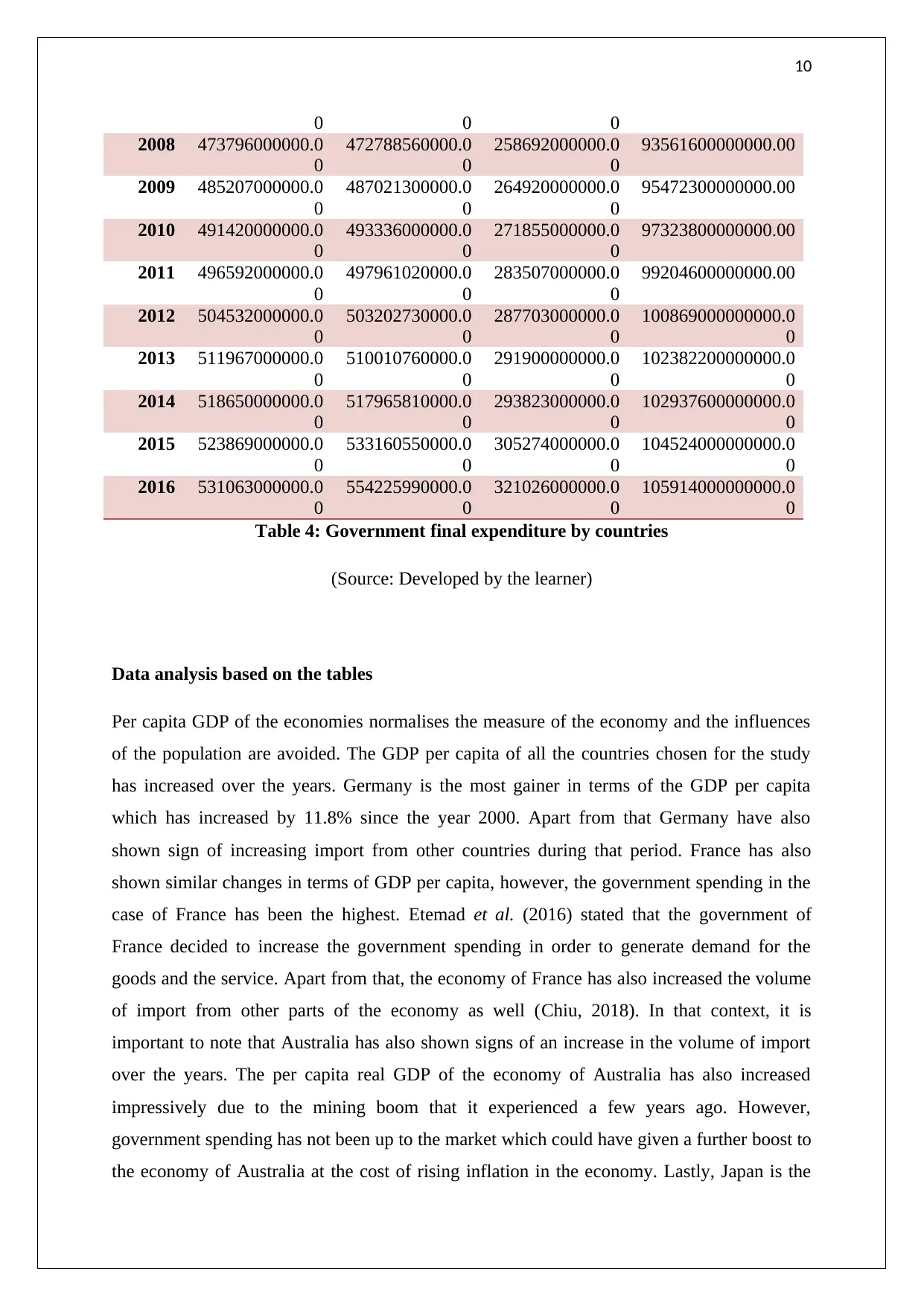
10
0 0 0
2008 473796000000.0
0
472788560000.0
0
258692000000.0
0
93561600000000.00
2009 485207000000.0
0
487021300000.0
0
264920000000.0
0
95472300000000.00
2010 491420000000.0
0
493336000000.0
0
271855000000.0
0
97323800000000.00
2011 496592000000.0
0
497961020000.0
0
283507000000.0
0
99204600000000.00
2012 504532000000.0
0
503202730000.0
0
287703000000.0
0
100869000000000.0
0
2013 511967000000.0
0
510010760000.0
0
291900000000.0
0
102382200000000.0
0
2014 518650000000.0
0
517965810000.0
0
293823000000.0
0
102937600000000.0
0
2015 523869000000.0
0
533160550000.0
0
305274000000.0
0
104524000000000.0
0
2016 531063000000.0
0
554225990000.0
0
321026000000.0
0
105914000000000.0
0
Table 4: Government final expenditure by countries
(Source: Developed by the learner)
Data analysis based on the tables
Per capita GDP of the economies normalises the measure of the economy and the influences
of the population are avoided. The GDP per capita of all the countries chosen for the study
has increased over the years. Germany is the most gainer in terms of the GDP per capita
which has increased by 11.8% since the year 2000. Apart from that Germany have also
shown sign of increasing import from other countries during that period. France has also
shown similar changes in terms of GDP per capita, however, the government spending in the
case of France has been the highest. Etemad et al. (2016) stated that the government of
France decided to increase the government spending in order to generate demand for the
goods and the service. Apart from that, the economy of France has also increased the volume
of import from other parts of the economy as well (Chiu, 2018). In that context, it is
important to note that Australia has also shown signs of an increase in the volume of import
over the years. The per capita real GDP of the economy of Australia has also increased
impressively due to the mining boom that it experienced a few years ago. However,
government spending has not been up to the market which could have given a further boost to
the economy of Australia at the cost of rising inflation in the economy. Lastly, Japan is the
0 0 0
2008 473796000000.0
0
472788560000.0
0
258692000000.0
0
93561600000000.00
2009 485207000000.0
0
487021300000.0
0
264920000000.0
0
95472300000000.00
2010 491420000000.0
0
493336000000.0
0
271855000000.0
0
97323800000000.00
2011 496592000000.0
0
497961020000.0
0
283507000000.0
0
99204600000000.00
2012 504532000000.0
0
503202730000.0
0
287703000000.0
0
100869000000000.0
0
2013 511967000000.0
0
510010760000.0
0
291900000000.0
0
102382200000000.0
0
2014 518650000000.0
0
517965810000.0
0
293823000000.0
0
102937600000000.0
0
2015 523869000000.0
0
533160550000.0
0
305274000000.0
0
104524000000000.0
0
2016 531063000000.0
0
554225990000.0
0
321026000000.0
0
105914000000000.0
0
Table 4: Government final expenditure by countries
(Source: Developed by the learner)
Data analysis based on the tables
Per capita GDP of the economies normalises the measure of the economy and the influences
of the population are avoided. The GDP per capita of all the countries chosen for the study
has increased over the years. Germany is the most gainer in terms of the GDP per capita
which has increased by 11.8% since the year 2000. Apart from that Germany have also
shown sign of increasing import from other countries during that period. France has also
shown similar changes in terms of GDP per capita, however, the government spending in the
case of France has been the highest. Etemad et al. (2016) stated that the government of
France decided to increase the government spending in order to generate demand for the
goods and the service. Apart from that, the economy of France has also increased the volume
of import from other parts of the economy as well (Chiu, 2018). In that context, it is
important to note that Australia has also shown signs of an increase in the volume of import
over the years. The per capita real GDP of the economy of Australia has also increased
impressively due to the mining boom that it experienced a few years ago. However,
government spending has not been up to the market which could have given a further boost to
the economy of Australia at the cost of rising inflation in the economy. Lastly, Japan is the
Secure Best Marks with AI Grader
Need help grading? Try our AI Grader for instant feedback on your assignments.
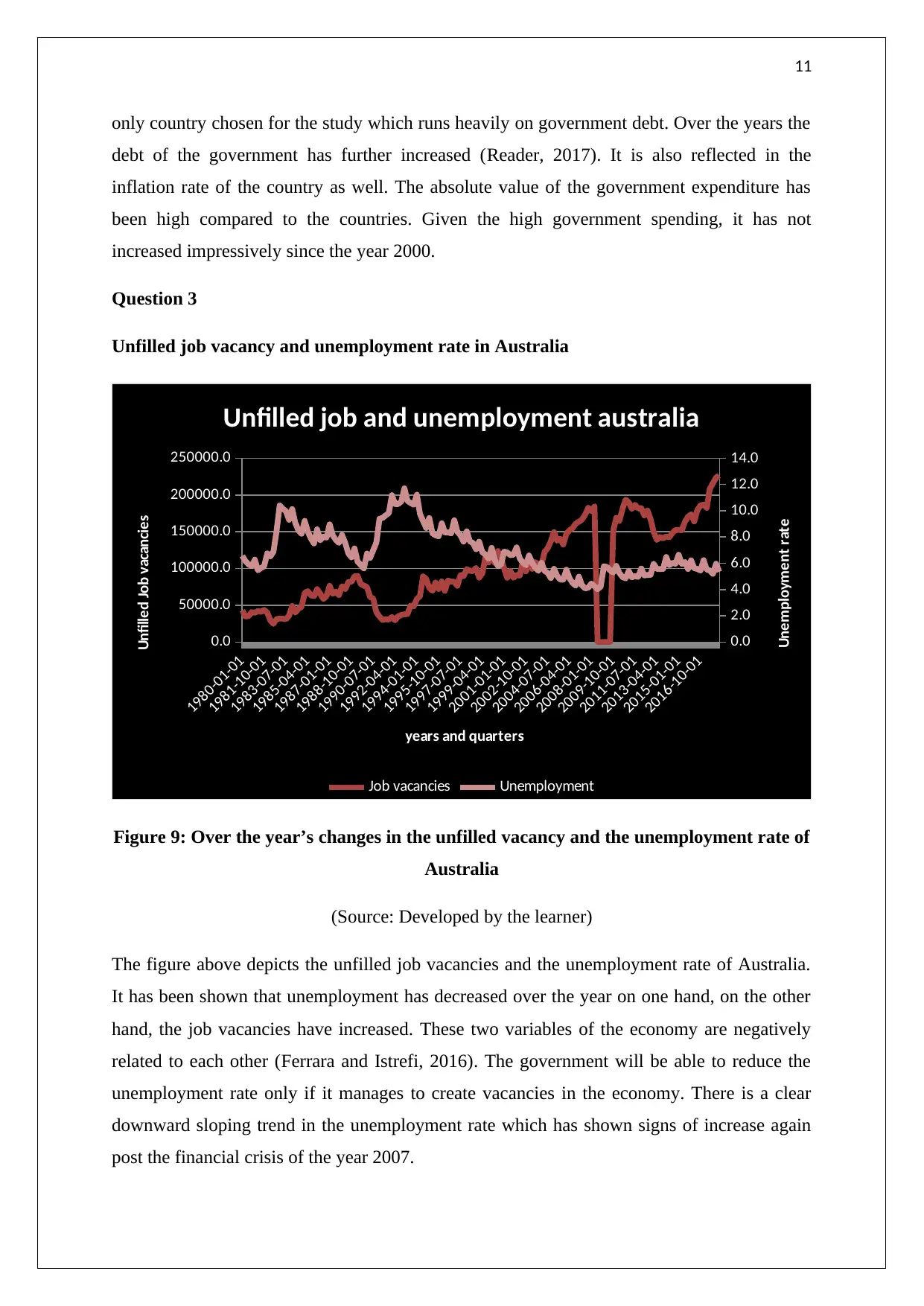
11
only country chosen for the study which runs heavily on government debt. Over the years the
debt of the government has further increased (Reader, 2017). It is also reflected in the
inflation rate of the country as well. The absolute value of the government expenditure has
been high compared to the countries. Given the high government spending, it has not
increased impressively since the year 2000.
Question 3
Unfilled job vacancy and unemployment rate in Australia
1980-01-01
1981-10-01
1983-07-01
1985-04-01
1987-01-01
1988-10-01
1990-07-01
1992-04-01
1994-01-01
1995-10-01
1997-07-01
1999-04-01
2001-01-01
2002-10-01
2004-07-01
2006-04-01
2008-01-01
2009-10-01
2011-07-01
2013-04-01
2015-01-01
2016-10-01
0.0
50000.0
100000.0
150000.0
200000.0
250000.0
0.0
2.0
4.0
6.0
8.0
10.0
12.0
14.0
Unfilled job and unemployment australia
Job vacancies Unemployment
years and quarters
Unfilled Job vacancies
Unemployment rate
Figure 9: Over the year’s changes in the unfilled vacancy and the unemployment rate of
Australia
(Source: Developed by the learner)
The figure above depicts the unfilled job vacancies and the unemployment rate of Australia.
It has been shown that unemployment has decreased over the year on one hand, on the other
hand, the job vacancies have increased. These two variables of the economy are negatively
related to each other (Ferrara and Istrefi, 2016). The government will be able to reduce the
unemployment rate only if it manages to create vacancies in the economy. There is a clear
downward sloping trend in the unemployment rate which has shown signs of increase again
post the financial crisis of the year 2007.
only country chosen for the study which runs heavily on government debt. Over the years the
debt of the government has further increased (Reader, 2017). It is also reflected in the
inflation rate of the country as well. The absolute value of the government expenditure has
been high compared to the countries. Given the high government spending, it has not
increased impressively since the year 2000.
Question 3
Unfilled job vacancy and unemployment rate in Australia
1980-01-01
1981-10-01
1983-07-01
1985-04-01
1987-01-01
1988-10-01
1990-07-01
1992-04-01
1994-01-01
1995-10-01
1997-07-01
1999-04-01
2001-01-01
2002-10-01
2004-07-01
2006-04-01
2008-01-01
2009-10-01
2011-07-01
2013-04-01
2015-01-01
2016-10-01
0.0
50000.0
100000.0
150000.0
200000.0
250000.0
0.0
2.0
4.0
6.0
8.0
10.0
12.0
14.0
Unfilled job and unemployment australia
Job vacancies Unemployment
years and quarters
Unfilled Job vacancies
Unemployment rate
Figure 9: Over the year’s changes in the unfilled vacancy and the unemployment rate of
Australia
(Source: Developed by the learner)
The figure above depicts the unfilled job vacancies and the unemployment rate of Australia.
It has been shown that unemployment has decreased over the year on one hand, on the other
hand, the job vacancies have increased. These two variables of the economy are negatively
related to each other (Ferrara and Istrefi, 2016). The government will be able to reduce the
unemployment rate only if it manages to create vacancies in the economy. There is a clear
downward sloping trend in the unemployment rate which has shown signs of increase again
post the financial crisis of the year 2007.
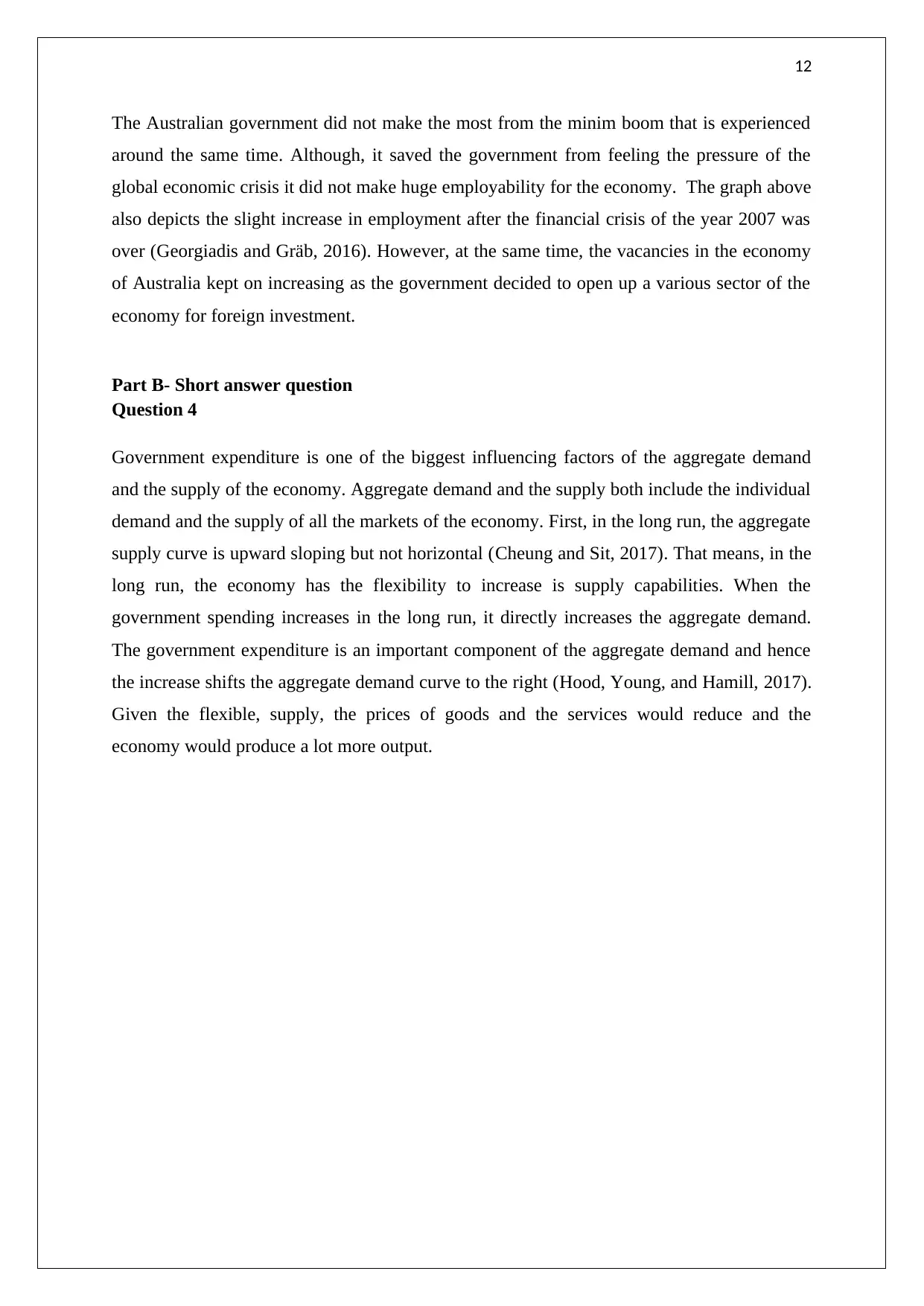
12
The Australian government did not make the most from the minim boom that is experienced
around the same time. Although, it saved the government from feeling the pressure of the
global economic crisis it did not make huge employability for the economy. The graph above
also depicts the slight increase in employment after the financial crisis of the year 2007 was
over (Georgiadis and Gräb, 2016). However, at the same time, the vacancies in the economy
of Australia kept on increasing as the government decided to open up a various sector of the
economy for foreign investment.
Part B- Short answer question
Question 4
Government expenditure is one of the biggest influencing factors of the aggregate demand
and the supply of the economy. Aggregate demand and the supply both include the individual
demand and the supply of all the markets of the economy. First, in the long run, the aggregate
supply curve is upward sloping but not horizontal (Cheung and Sit, 2017). That means, in the
long run, the economy has the flexibility to increase is supply capabilities. When the
government spending increases in the long run, it directly increases the aggregate demand.
The government expenditure is an important component of the aggregate demand and hence
the increase shifts the aggregate demand curve to the right (Hood, Young, and Hamill, 2017).
Given the flexible, supply, the prices of goods and the services would reduce and the
economy would produce a lot more output.
The Australian government did not make the most from the minim boom that is experienced
around the same time. Although, it saved the government from feeling the pressure of the
global economic crisis it did not make huge employability for the economy. The graph above
also depicts the slight increase in employment after the financial crisis of the year 2007 was
over (Georgiadis and Gräb, 2016). However, at the same time, the vacancies in the economy
of Australia kept on increasing as the government decided to open up a various sector of the
economy for foreign investment.
Part B- Short answer question
Question 4
Government expenditure is one of the biggest influencing factors of the aggregate demand
and the supply of the economy. Aggregate demand and the supply both include the individual
demand and the supply of all the markets of the economy. First, in the long run, the aggregate
supply curve is upward sloping but not horizontal (Cheung and Sit, 2017). That means, in the
long run, the economy has the flexibility to increase is supply capabilities. When the
government spending increases in the long run, it directly increases the aggregate demand.
The government expenditure is an important component of the aggregate demand and hence
the increase shifts the aggregate demand curve to the right (Hood, Young, and Hamill, 2017).
Given the flexible, supply, the prices of goods and the services would reduce and the
economy would produce a lot more output.
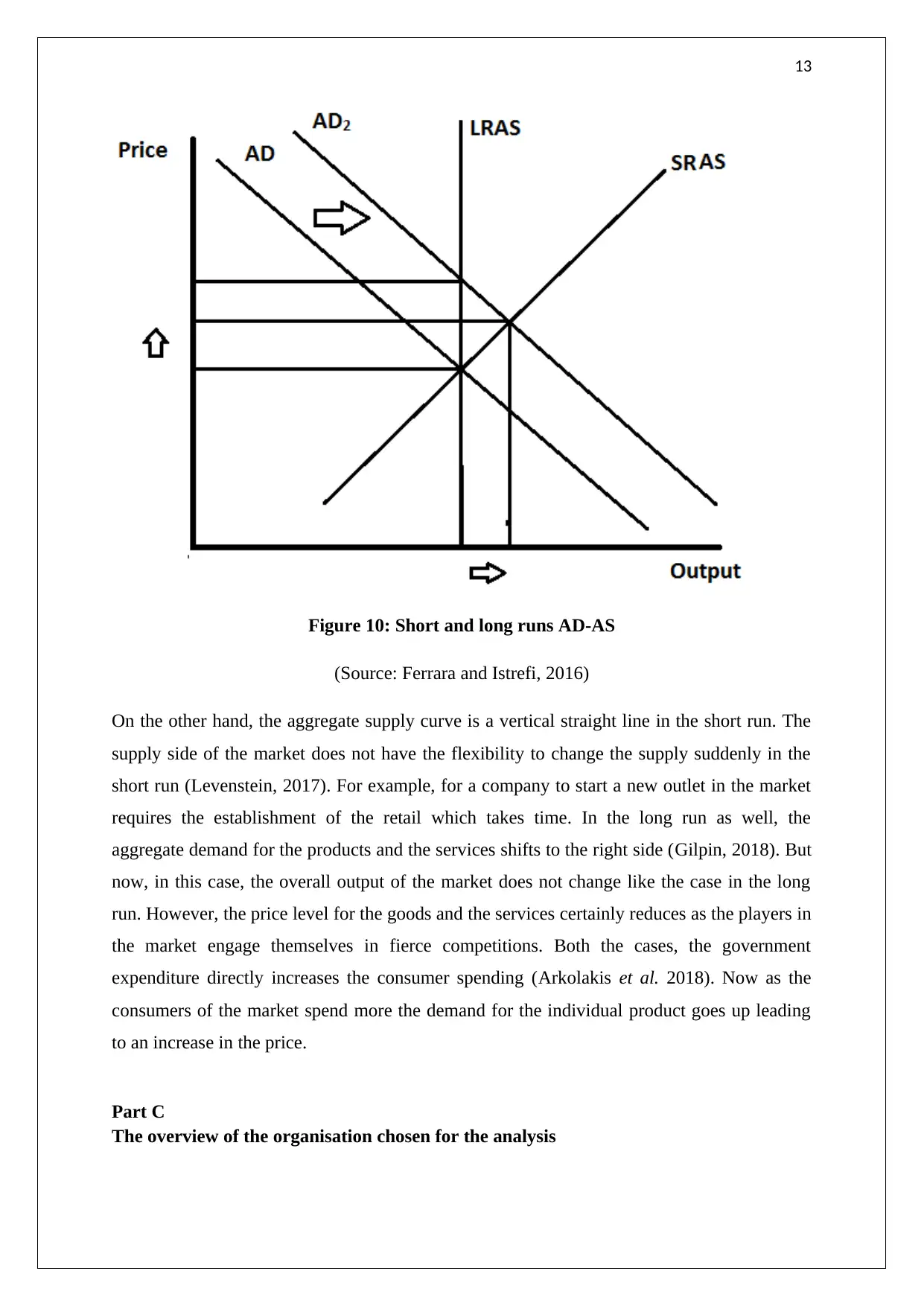
13
Figure 10: Short and long runs AD-AS
(Source: Ferrara and Istrefi, 2016)
On the other hand, the aggregate supply curve is a vertical straight line in the short run. The
supply side of the market does not have the flexibility to change the supply suddenly in the
short run (Levenstein, 2017). For example, for a company to start a new outlet in the market
requires the establishment of the retail which takes time. In the long run as well, the
aggregate demand for the products and the services shifts to the right side (Gilpin, 2018). But
now, in this case, the overall output of the market does not change like the case in the long
run. However, the price level for the goods and the services certainly reduces as the players in
the market engage themselves in fierce competitions. Both the cases, the government
expenditure directly increases the consumer spending (Arkolakis et al. 2018). Now as the
consumers of the market spend more the demand for the individual product goes up leading
to an increase in the price.
Part C
The overview of the organisation chosen for the analysis
Figure 10: Short and long runs AD-AS
(Source: Ferrara and Istrefi, 2016)
On the other hand, the aggregate supply curve is a vertical straight line in the short run. The
supply side of the market does not have the flexibility to change the supply suddenly in the
short run (Levenstein, 2017). For example, for a company to start a new outlet in the market
requires the establishment of the retail which takes time. In the long run as well, the
aggregate demand for the products and the services shifts to the right side (Gilpin, 2018). But
now, in this case, the overall output of the market does not change like the case in the long
run. However, the price level for the goods and the services certainly reduces as the players in
the market engage themselves in fierce competitions. Both the cases, the government
expenditure directly increases the consumer spending (Arkolakis et al. 2018). Now as the
consumers of the market spend more the demand for the individual product goes up leading
to an increase in the price.
Part C
The overview of the organisation chosen for the analysis
Paraphrase This Document
Need a fresh take? Get an instant paraphrase of this document with our AI Paraphraser
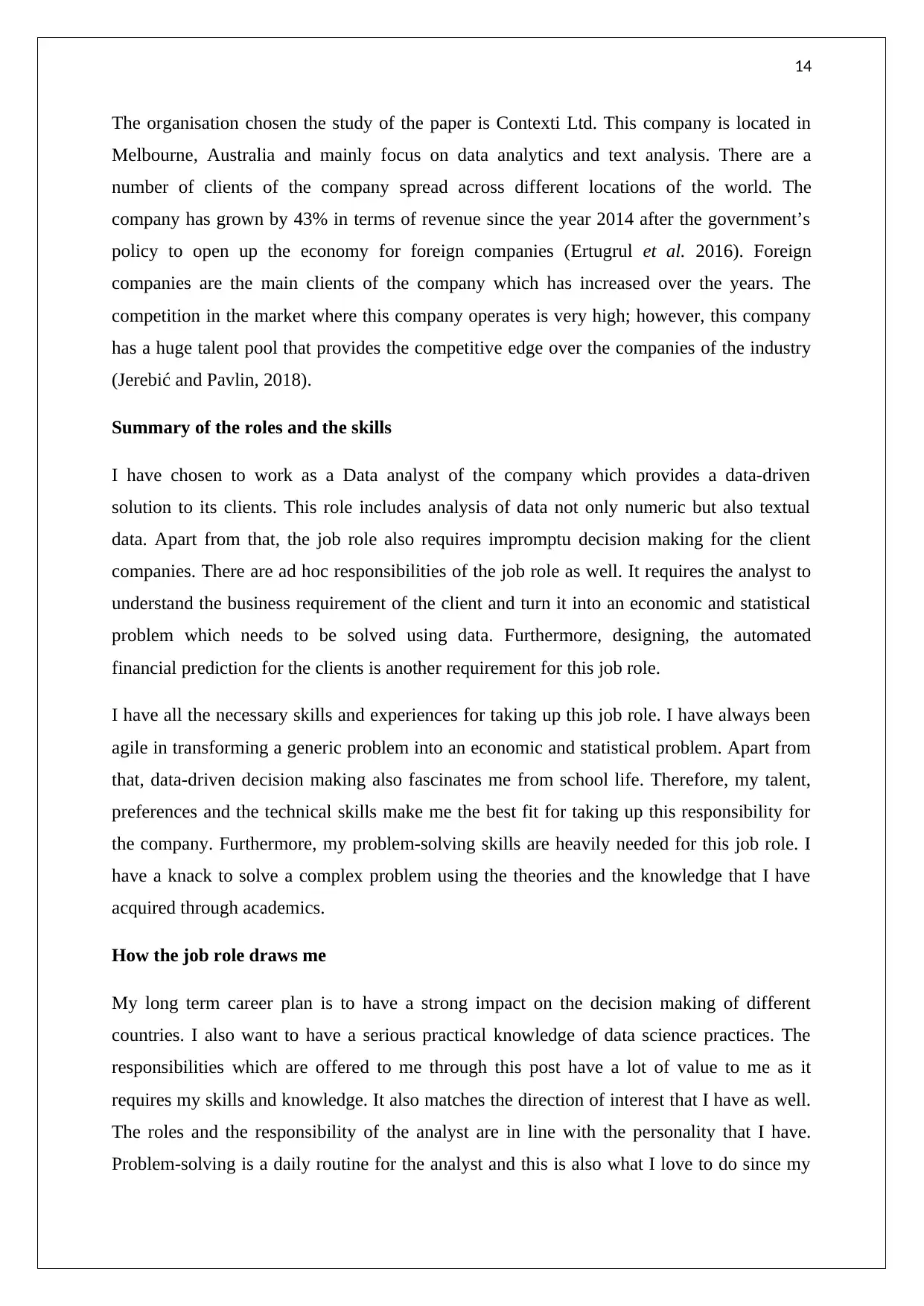
14
The organisation chosen the study of the paper is Contexti Ltd. This company is located in
Melbourne, Australia and mainly focus on data analytics and text analysis. There are a
number of clients of the company spread across different locations of the world. The
company has grown by 43% in terms of revenue since the year 2014 after the government’s
policy to open up the economy for foreign companies (Ertugrul et al. 2016). Foreign
companies are the main clients of the company which has increased over the years. The
competition in the market where this company operates is very high; however, this company
has a huge talent pool that provides the competitive edge over the companies of the industry
(Jerebić and Pavlin, 2018).
Summary of the roles and the skills
I have chosen to work as a Data analyst of the company which provides a data-driven
solution to its clients. This role includes analysis of data not only numeric but also textual
data. Apart from that, the job role also requires impromptu decision making for the client
companies. There are ad hoc responsibilities of the job role as well. It requires the analyst to
understand the business requirement of the client and turn it into an economic and statistical
problem which needs to be solved using data. Furthermore, designing, the automated
financial prediction for the clients is another requirement for this job role.
I have all the necessary skills and experiences for taking up this job role. I have always been
agile in transforming a generic problem into an economic and statistical problem. Apart from
that, data-driven decision making also fascinates me from school life. Therefore, my talent,
preferences and the technical skills make me the best fit for taking up this responsibility for
the company. Furthermore, my problem-solving skills are heavily needed for this job role. I
have a knack to solve a complex problem using the theories and the knowledge that I have
acquired through academics.
How the job role draws me
My long term career plan is to have a strong impact on the decision making of different
countries. I also want to have a serious practical knowledge of data science practices. The
responsibilities which are offered to me through this post have a lot of value to me as it
requires my skills and knowledge. It also matches the direction of interest that I have as well.
The roles and the responsibility of the analyst are in line with the personality that I have.
Problem-solving is a daily routine for the analyst and this is also what I love to do since my
The organisation chosen the study of the paper is Contexti Ltd. This company is located in
Melbourne, Australia and mainly focus on data analytics and text analysis. There are a
number of clients of the company spread across different locations of the world. The
company has grown by 43% in terms of revenue since the year 2014 after the government’s
policy to open up the economy for foreign companies (Ertugrul et al. 2016). Foreign
companies are the main clients of the company which has increased over the years. The
competition in the market where this company operates is very high; however, this company
has a huge talent pool that provides the competitive edge over the companies of the industry
(Jerebić and Pavlin, 2018).
Summary of the roles and the skills
I have chosen to work as a Data analyst of the company which provides a data-driven
solution to its clients. This role includes analysis of data not only numeric but also textual
data. Apart from that, the job role also requires impromptu decision making for the client
companies. There are ad hoc responsibilities of the job role as well. It requires the analyst to
understand the business requirement of the client and turn it into an economic and statistical
problem which needs to be solved using data. Furthermore, designing, the automated
financial prediction for the clients is another requirement for this job role.
I have all the necessary skills and experiences for taking up this job role. I have always been
agile in transforming a generic problem into an economic and statistical problem. Apart from
that, data-driven decision making also fascinates me from school life. Therefore, my talent,
preferences and the technical skills make me the best fit for taking up this responsibility for
the company. Furthermore, my problem-solving skills are heavily needed for this job role. I
have a knack to solve a complex problem using the theories and the knowledge that I have
acquired through academics.
How the job role draws me
My long term career plan is to have a strong impact on the decision making of different
countries. I also want to have a serious practical knowledge of data science practices. The
responsibilities which are offered to me through this post have a lot of value to me as it
requires my skills and knowledge. It also matches the direction of interest that I have as well.
The roles and the responsibility of the analyst are in line with the personality that I have.
Problem-solving is a daily routine for the analyst and this is also what I love to do since my
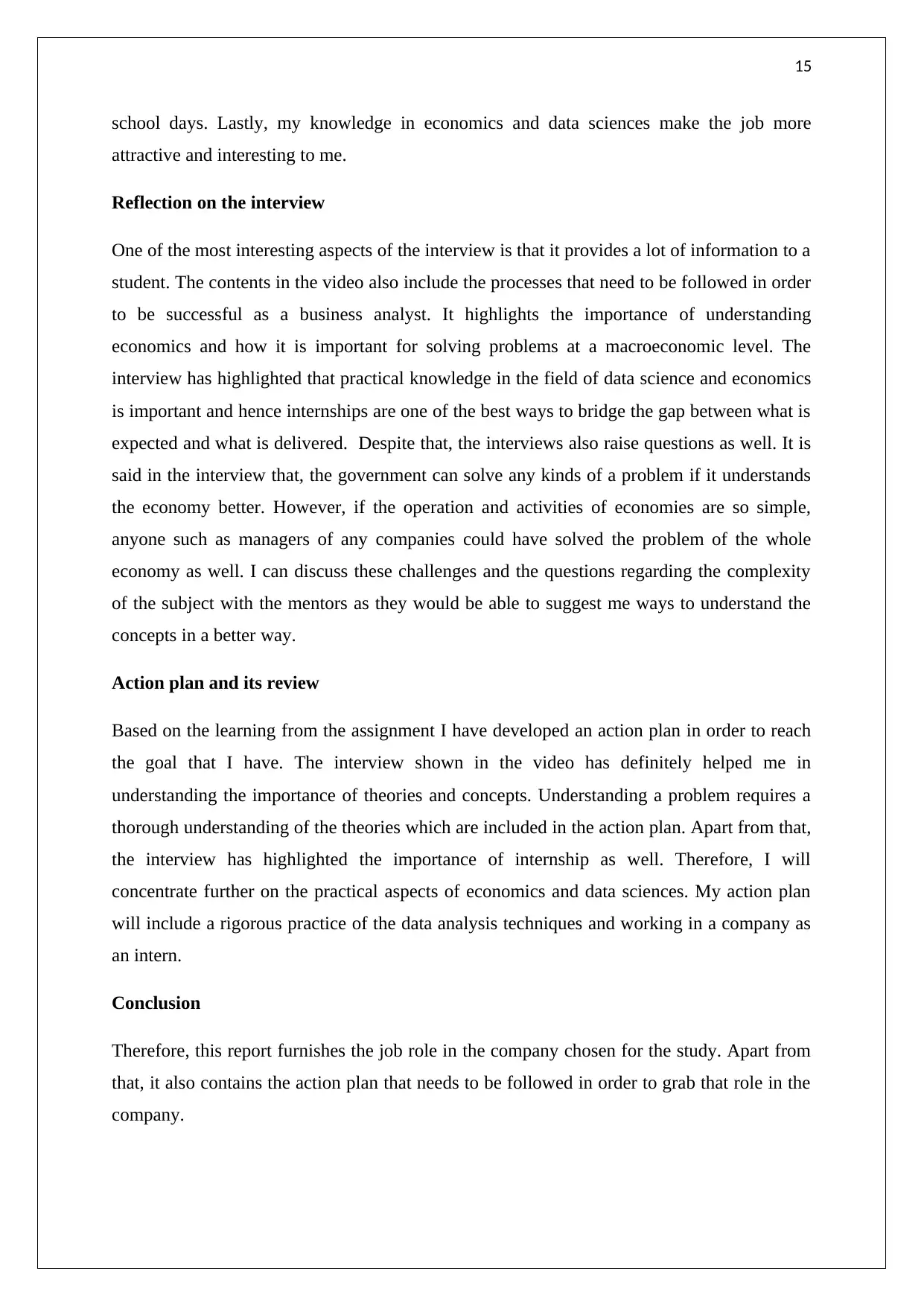
15
school days. Lastly, my knowledge in economics and data sciences make the job more
attractive and interesting to me.
Reflection on the interview
One of the most interesting aspects of the interview is that it provides a lot of information to a
student. The contents in the video also include the processes that need to be followed in order
to be successful as a business analyst. It highlights the importance of understanding
economics and how it is important for solving problems at a macroeconomic level. The
interview has highlighted that practical knowledge in the field of data science and economics
is important and hence internships are one of the best ways to bridge the gap between what is
expected and what is delivered. Despite that, the interviews also raise questions as well. It is
said in the interview that, the government can solve any kinds of a problem if it understands
the economy better. However, if the operation and activities of economies are so simple,
anyone such as managers of any companies could have solved the problem of the whole
economy as well. I can discuss these challenges and the questions regarding the complexity
of the subject with the mentors as they would be able to suggest me ways to understand the
concepts in a better way.
Action plan and its review
Based on the learning from the assignment I have developed an action plan in order to reach
the goal that I have. The interview shown in the video has definitely helped me in
understanding the importance of theories and concepts. Understanding a problem requires a
thorough understanding of the theories which are included in the action plan. Apart from that,
the interview has highlighted the importance of internship as well. Therefore, I will
concentrate further on the practical aspects of economics and data sciences. My action plan
will include a rigorous practice of the data analysis techniques and working in a company as
an intern.
Conclusion
Therefore, this report furnishes the job role in the company chosen for the study. Apart from
that, it also contains the action plan that needs to be followed in order to grab that role in the
company.
school days. Lastly, my knowledge in economics and data sciences make the job more
attractive and interesting to me.
Reflection on the interview
One of the most interesting aspects of the interview is that it provides a lot of information to a
student. The contents in the video also include the processes that need to be followed in order
to be successful as a business analyst. It highlights the importance of understanding
economics and how it is important for solving problems at a macroeconomic level. The
interview has highlighted that practical knowledge in the field of data science and economics
is important and hence internships are one of the best ways to bridge the gap between what is
expected and what is delivered. Despite that, the interviews also raise questions as well. It is
said in the interview that, the government can solve any kinds of a problem if it understands
the economy better. However, if the operation and activities of economies are so simple,
anyone such as managers of any companies could have solved the problem of the whole
economy as well. I can discuss these challenges and the questions regarding the complexity
of the subject with the mentors as they would be able to suggest me ways to understand the
concepts in a better way.
Action plan and its review
Based on the learning from the assignment I have developed an action plan in order to reach
the goal that I have. The interview shown in the video has definitely helped me in
understanding the importance of theories and concepts. Understanding a problem requires a
thorough understanding of the theories which are included in the action plan. Apart from that,
the interview has highlighted the importance of internship as well. Therefore, I will
concentrate further on the practical aspects of economics and data sciences. My action plan
will include a rigorous practice of the data analysis techniques and working in a company as
an intern.
Conclusion
Therefore, this report furnishes the job role in the company chosen for the study. Apart from
that, it also contains the action plan that needs to be followed in order to grab that role in the
company.
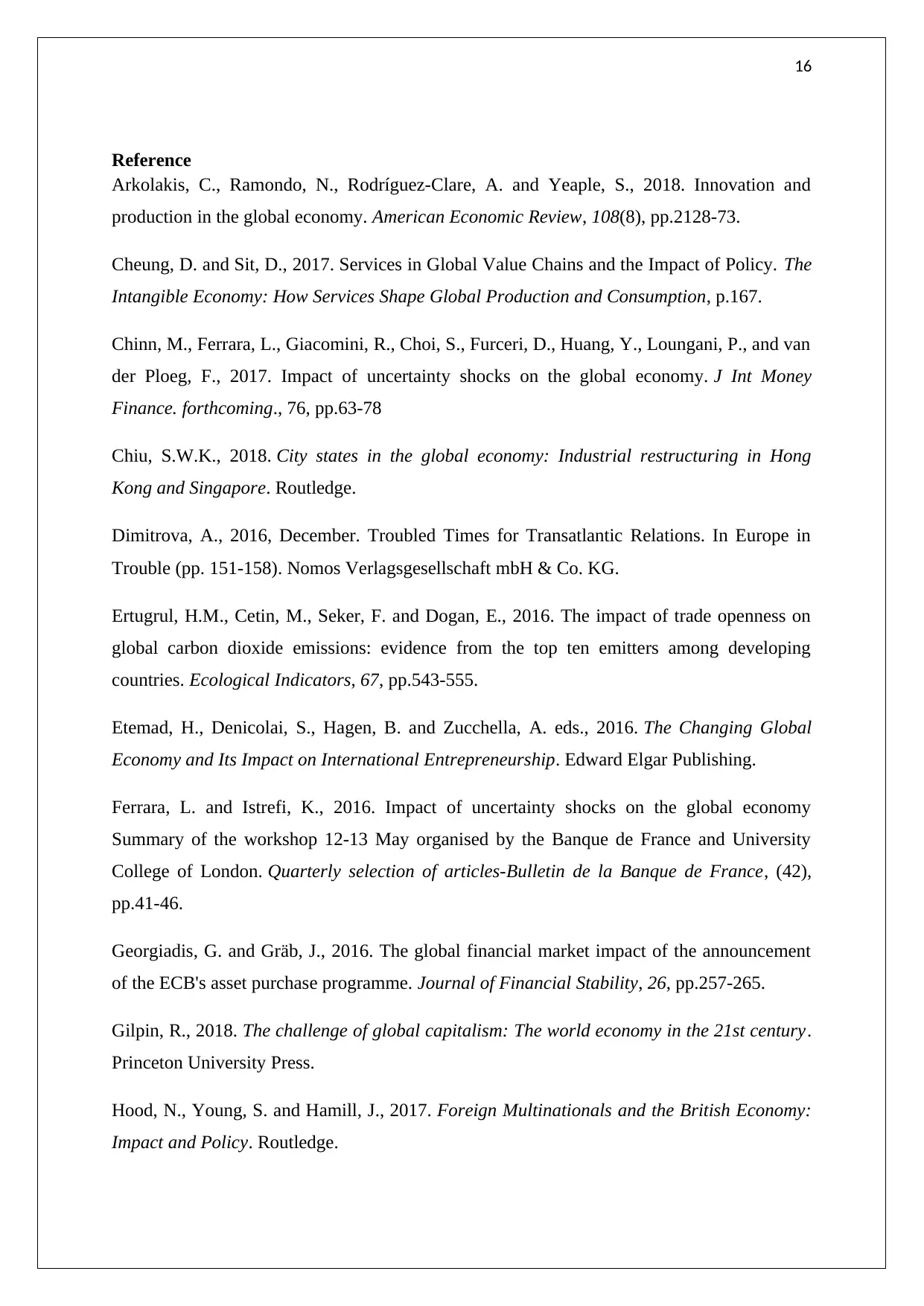
16
Reference
Arkolakis, C., Ramondo, N., Rodríguez-Clare, A. and Yeaple, S., 2018. Innovation and
production in the global economy. American Economic Review, 108(8), pp.2128-73.
Cheung, D. and Sit, D., 2017. Services in Global Value Chains and the Impact of Policy. The
Intangible Economy: How Services Shape Global Production and Consumption, p.167.
Chinn, M., Ferrara, L., Giacomini, R., Choi, S., Furceri, D., Huang, Y., Loungani, P., and van
der Ploeg, F., 2017. Impact of uncertainty shocks on the global economy. J Int Money
Finance. forthcoming., 76, pp.63-78
Chiu, S.W.K., 2018. City states in the global economy: Industrial restructuring in Hong
Kong and Singapore. Routledge.
Dimitrova, A., 2016, December. Troubled Times for Transatlantic Relations. In Europe in
Trouble (pp. 151-158). Nomos Verlagsgesellschaft mbH & Co. KG.
Ertugrul, H.M., Cetin, M., Seker, F. and Dogan, E., 2016. The impact of trade openness on
global carbon dioxide emissions: evidence from the top ten emitters among developing
countries. Ecological Indicators, 67, pp.543-555.
Etemad, H., Denicolai, S., Hagen, B. and Zucchella, A. eds., 2016. The Changing Global
Economy and Its Impact on International Entrepreneurship. Edward Elgar Publishing.
Ferrara, L. and Istrefi, K., 2016. Impact of uncertainty shocks on the global economy
Summary of the workshop 12-13 May organised by the Banque de France and University
College of London. Quarterly selection of articles-Bulletin de la Banque de France, (42),
pp.41-46.
Georgiadis, G. and Gräb, J., 2016. The global financial market impact of the announcement
of the ECB's asset purchase programme. Journal of Financial Stability, 26, pp.257-265.
Gilpin, R., 2018. The challenge of global capitalism: The world economy in the 21st century.
Princeton University Press.
Hood, N., Young, S. and Hamill, J., 2017. Foreign Multinationals and the British Economy:
Impact and Policy. Routledge.
Reference
Arkolakis, C., Ramondo, N., Rodríguez-Clare, A. and Yeaple, S., 2018. Innovation and
production in the global economy. American Economic Review, 108(8), pp.2128-73.
Cheung, D. and Sit, D., 2017. Services in Global Value Chains and the Impact of Policy. The
Intangible Economy: How Services Shape Global Production and Consumption, p.167.
Chinn, M., Ferrara, L., Giacomini, R., Choi, S., Furceri, D., Huang, Y., Loungani, P., and van
der Ploeg, F., 2017. Impact of uncertainty shocks on the global economy. J Int Money
Finance. forthcoming., 76, pp.63-78
Chiu, S.W.K., 2018. City states in the global economy: Industrial restructuring in Hong
Kong and Singapore. Routledge.
Dimitrova, A., 2016, December. Troubled Times for Transatlantic Relations. In Europe in
Trouble (pp. 151-158). Nomos Verlagsgesellschaft mbH & Co. KG.
Ertugrul, H.M., Cetin, M., Seker, F. and Dogan, E., 2016. The impact of trade openness on
global carbon dioxide emissions: evidence from the top ten emitters among developing
countries. Ecological Indicators, 67, pp.543-555.
Etemad, H., Denicolai, S., Hagen, B. and Zucchella, A. eds., 2016. The Changing Global
Economy and Its Impact on International Entrepreneurship. Edward Elgar Publishing.
Ferrara, L. and Istrefi, K., 2016. Impact of uncertainty shocks on the global economy
Summary of the workshop 12-13 May organised by the Banque de France and University
College of London. Quarterly selection of articles-Bulletin de la Banque de France, (42),
pp.41-46.
Georgiadis, G. and Gräb, J., 2016. The global financial market impact of the announcement
of the ECB's asset purchase programme. Journal of Financial Stability, 26, pp.257-265.
Gilpin, R., 2018. The challenge of global capitalism: The world economy in the 21st century.
Princeton University Press.
Hood, N., Young, S. and Hamill, J., 2017. Foreign Multinationals and the British Economy:
Impact and Policy. Routledge.
Secure Best Marks with AI Grader
Need help grading? Try our AI Grader for instant feedback on your assignments.

17
Jerebić, V. and Pavlin, S., 2018. Global Economy Crisis and its Impact on Operational
Container Carrier’s Strategy. Promet-Traffic&Transportation, 30(2), pp.187-194.
Levenstein, C., 2017. Work and Health in the Global Economy: Lessons from Developing
and Industrialized Countries on the Impact of Work on Health. In At the Point of
Production (pp. 13-38). Routledge.
Reader, J., 2017. Reconstructing practical theology: The impact of globalization. Routledge.
Jerebić, V. and Pavlin, S., 2018. Global Economy Crisis and its Impact on Operational
Container Carrier’s Strategy. Promet-Traffic&Transportation, 30(2), pp.187-194.
Levenstein, C., 2017. Work and Health in the Global Economy: Lessons from Developing
and Industrialized Countries on the Impact of Work on Health. In At the Point of
Production (pp. 13-38). Routledge.
Reader, J., 2017. Reconstructing practical theology: The impact of globalization. Routledge.
1 out of 17
Your All-in-One AI-Powered Toolkit for Academic Success.
+13062052269
info@desklib.com
Available 24*7 on WhatsApp / Email
![[object Object]](/_next/static/media/star-bottom.7253800d.svg)
Unlock your academic potential
© 2024 | Zucol Services PVT LTD | All rights reserved.